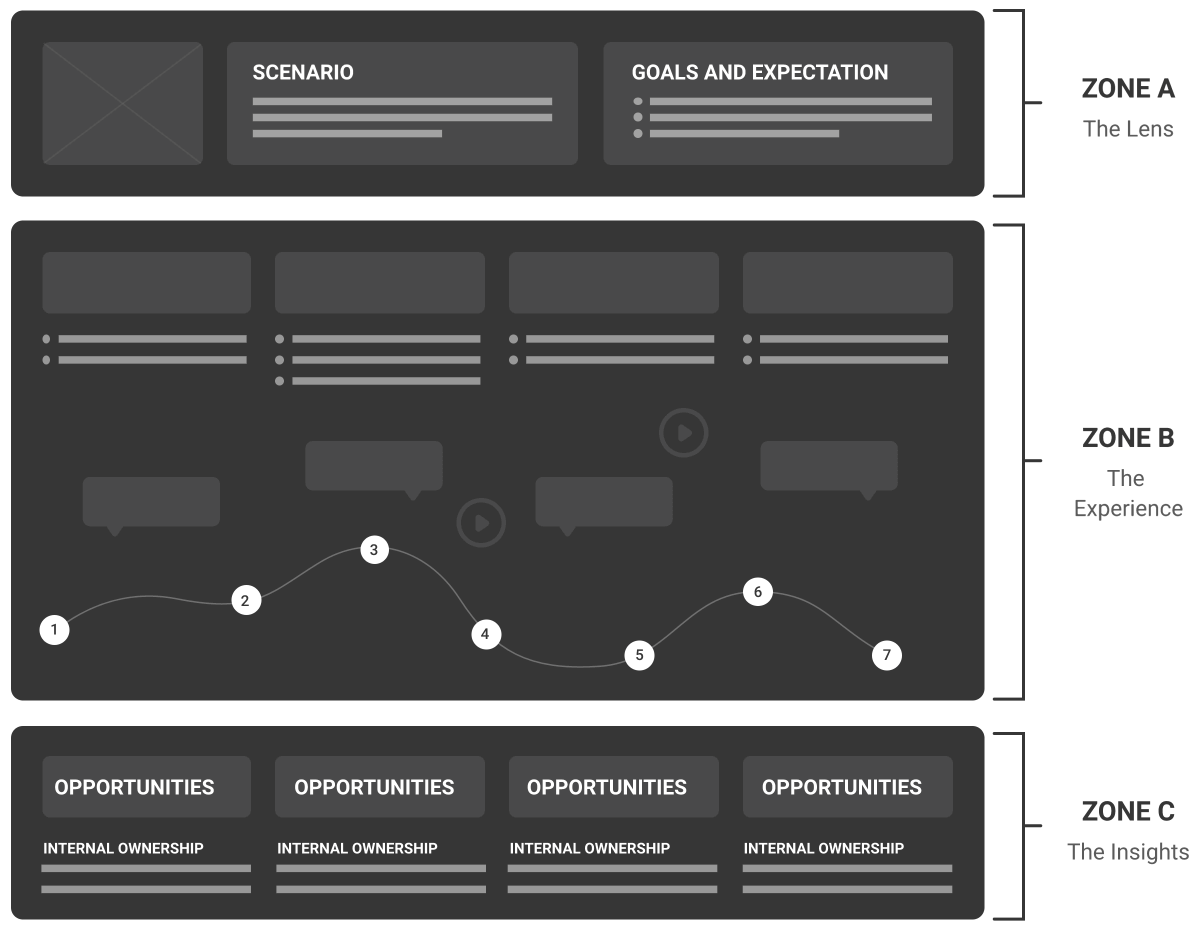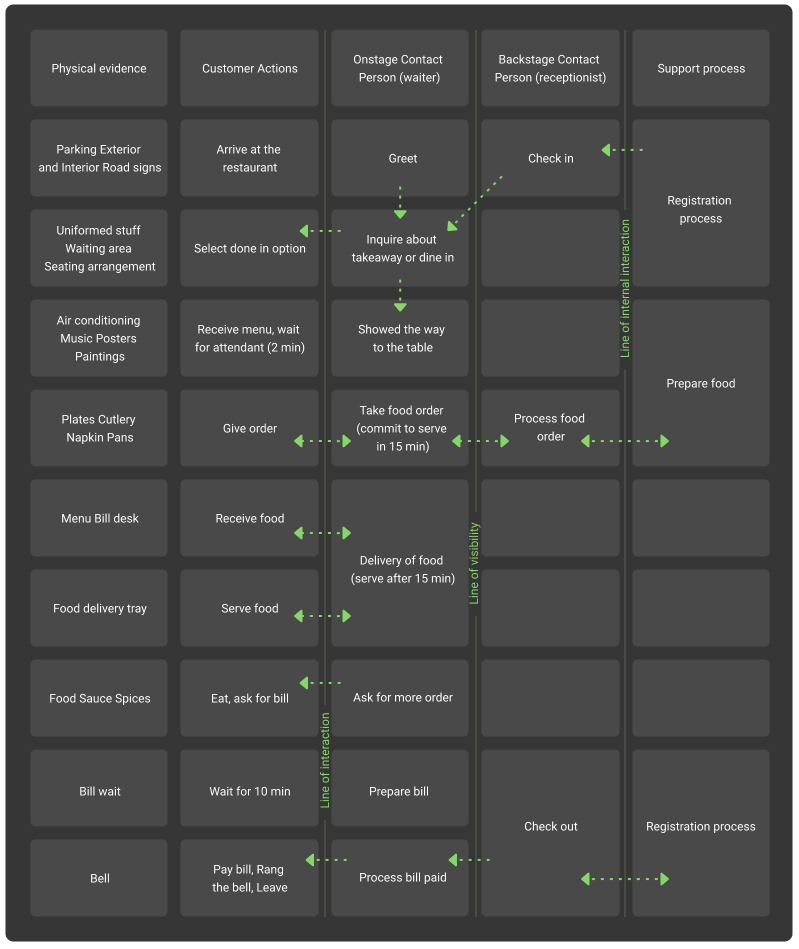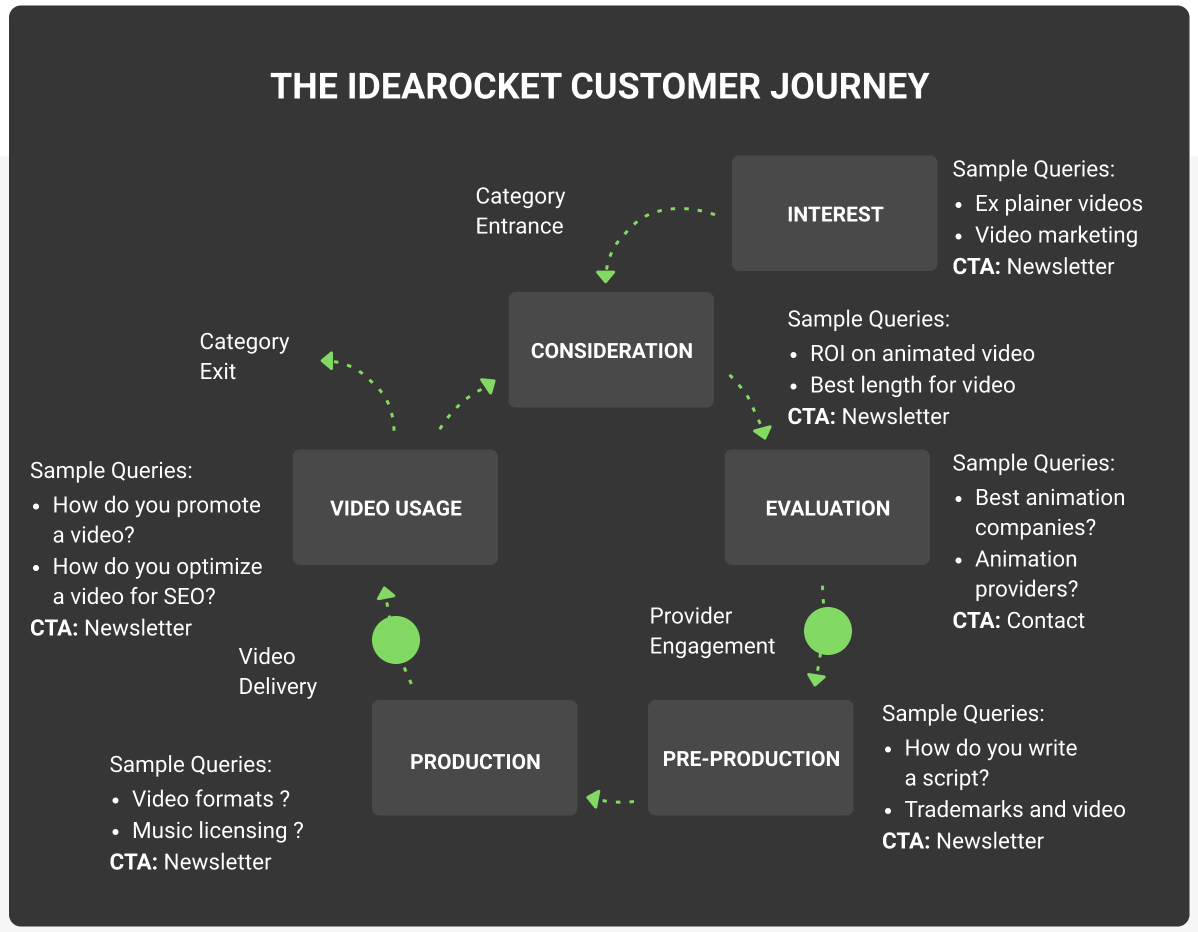Any business seeks opportunities to increase the sales of products and services, create a positive image, and attract more customers. The modern market is overflowing with many offers, so every company tries to implement unique services to increase customer interaction. But is it always effective? In the pursuit of new customers and rising popularity, many companies are missing out on one essential detail. Today we will talk about what a customer journey map is, why it is important, and how it affects business. We will also consider all the main steps to create a good customer journey map for any industry.
What is a Customer Journey Map?
Let's take a closer look at what a customer journey map is. It is a visual representation of a customer's experience with your product or service. The map describes all the customer touchpoints, from the moment they came to your site to a time when they made a purchase.
A client journey map describes a variety of emotions, from excitement to disappointment. But why is it so important for business? It is a tool that helps to map how customers move through the sales funnel. Building a customer journey map allows you to understand what steps you can take to increase your sales. In general, a customer journey is a more targeted path (focusing on one specific area) and a part of the standard process known as customer experience mapping (visualization of the complete picture).
Main Parts of Customer Journey Maps
A professional map captures two main aspects, storytelling and visualization. These are very effective mechanisms for the transfer of information and its subsequent management, which in turn influences ways to improve the quality of customer service. Although maps can differ significantly, let's take a look at their main components.

Zone A: Has a description of what (persona) and what (scenario) must be studied.
Zone B: It is a visualized client experience that reflects actions, thoughts, and emotions.
Zone C: Research result. It differs depending on the business goals, but it can show ideas for improving the service, overexposed pain points, opportunities for promotion, and so on.
Exceptional customer experiences are the only sustainable platform for competitive differentiation.
– Kerry Bodine, Founder of Kerry Bodine & Co.
Key Elements of Customer Journey Maps
It should be noted that the map should be unique for each brand or company, but they all have common elements, namely:
Personas. You should know your potential user perfectly. Their age, gender, hobbies, region, education, and even eye color if it affects your sales. It is based on the target audience that the map is built. The best sales process for goods and services depends on customer satisfaction. Without knowing your target clients, you cannot create a successful marketing campaign.
Timeline. The timeline reflects different periods, depending on the objectives of the map. It can show the steps of the sales funnel, which includes several hours to several days. And it can display the whole process, including after-sales service, in which case the time period can be extended from several months to a year.
Touchpoints. These are the points where customers directly interact with your brand. This step includes responding to emails, watching tutorial videos, accessing resources on a website, and so on.
Tool. This is how you interact with your customers. For example, you send a promotional offer by email, the user opens it and goes to the landing page. In this case, both the email and the landing page are tools for interacting with a client.
Emotions. Emotions largely drive people when shopping. Harvard professor Gerald Zaltman claims, “95% of our purchase decision making takes place in the subconscious mind”. Thus, understanding consumers' emotions are the key to managing your sales.
Types of Customer Journey Maps
By mapping the customer journey, you go beyond superficial assumptions about your clients and move on to what drives their buying behavior. This is a unique result of the work of various specialists in the field of marketing and design. Here are some of the most common examples of maps you can rely on in your product promotion strategy.
1. Current-State Customer Journey Map
Many companies use a full customer focus model. This means that to promote their business, they need an understanding of the current state of customers. And we come to the aim of the Current-State customer journey map. It contains a description of everything that the client thinks, feels, does, etc., while interacting with the target company. Developing such a map is also an opportunity to find new directions for your promotion strategy and improve brand engagement.
2. Day-in-the-Life Customer Journey Map
This map is similar to the previous type, but with one significant difference. The Day-in-the-Life map allows you to create a more detailed picture of the client's state and describe actions that are not directly related to your company’s interaction. This map has a narrower evaluation period and can track the client's actions by hours during the day. For example, what time they checked Instagram, when they opened their email, how much time they spent at work, and so on. Day-in-the-Life maps open up pain points in clients’ lives, allowing you to discover new aspects to meet the client’s needs and promote your services. In simpler terms, they explain the client's day, based on which you can improve your communication approach.
3. Future-State Customer Journey Map
This type of map describes everything that a client or potential buyer will feel and do in the context of ideal circumstances. Its goal is to improve interaction with consumers by identifying the steps that the company can take to achieve this ideal prospect. Future-State maps are used when you want to bring a new product or service to the market.
4. Blueprint Customer Journey Maps
This type of map describes the paths that customers and your company must take to meet each other. It starts with any of the previous three journey types and then builds on 'systems' to deliver exceptional experiences that include staff, companies, technology, processes, and so on. Blueprint Customer Journey Maps allow you to understand precisely where your customers are located and where they will be in the future, as well as predict how your products or services will help meet their needs.
Key Benefits of Customer Journey Mapping
According to a study by the Aberdeen Group, companies that create a customer journey map get a return on marketing investment of 29% year over year and reduce in-service costs by about 21.2%. But, customer experience journey mapping will not only bring you extra revenue; it is also an opportunity to build long-term and promising relationships with clients and strengthen your brand.
You might think that you don't need it because you already have a well-thought-out marketing campaign. But this is a delusion. By breaking down the entire customer experience cycle into critical milestones and points of contact, you will maximize your products or services’ long-term success and popularity. We have highlighted several main benefits of customer journey mapping that will benefit any business:
1. Focus on inbound marketing
Many companies focus on outbound marketing. This is when you promote a product or service through direct advertising. In any of these cases, the purchase is always initiated by the company, not the customers. Outbound marketing costs can be enormous and do not always pay off. They may be poorly customer-focused or try to reach too broad an audience, reducing its effectiveness. Besides, the abundance of aggressive advertising scares off consumers, so you have to come up with new tricks to keep their attention every year.
Inbound marketing is something else. It is about creating engaging and useful content that consumers want. Its essence is that first, it attracts their attention, and then customers focus on shopping. In this case, a customer journey map allows you to assess what is exciting and useful to your users, and what exactly attracts them to your site, and what, on the contrary, repels. This way, you can adjust your content in such a way as to keep clients’ maximum attention.
2. Build a new target clients base
Attracting a wide range of different users is a disastrous undertaking that can be expensive and not bring a return on investment at all. You must have a good knowledge of your customers’ demographic and psychographic data to be effective for your marketing. The way to make your product in demand and useful for a long time is by studying your consumers’ behavior, their pain points, needs, desires, and emotions. By creating a customer journey map, you can effectively hone your marketing and attract leads at less cost.
3. Improve the quality of service
By carefully analyzing the clients' journey, you will find not only those moments where they will experience joy and delight but also situations in which the client is uncomfortable. Knowing these nuances, you can significantly raise the level of customer service. It also increases the level of consumer confidence. A simple example of this approach is when you notify customers in advance of a change in your work schedule due to holidays or other changes in the company. It is a form of care that can also help clients make purchases in advance.
4. Grow customer retention rate
By having a complete understanding of what the user is doing at each step of the buying process, you can reduce or eliminate pain points. This, in turn, will lead to higher customer retention rates. According to statistics, 33% of Americans will abandon the company if they faced poor customer service.
5. Improve the corporate policy of the company
When you know how to make a journey map and put it into practice, you help the entire company's departments be completely customer-focused. Thus, support, marketing, sales, and so on are restructured and worked in accordance with a unified philosophy based on the desires of real consumers.
Why Do You Need It?
Customer journey maps always support a specific business goal. Templates that don't fit a particular purpose don't usually provide useful information. At the same time, the goals can be different, both internally and externally, allowing them to determine what stands in the user's path and prevents them from making a purchase. Here are some potential business goals to which the process of mapping examples can be applied.
1. Changing the company's point of view
If there are processes, indicators, systems, or guidelines within the business that directly affect customer service quality, the mapping will help identify and improve these processes. Thus, the company can reorient itself to consumers’ needs and emotions, satisfying them with internal resources. This method sheds light on the operations of the organization that remain underestimated.
2. Reorganization of departments and attraction of investments
Customer journey maps allow you to evaluate the actions and productivity of the various departments in the organization, thanks to which the customer comes into contact with the brand. Identification of their weaknesses will help reform the structure effectively and, if necessary, justify investments’ feasibility.
3. Studying the purchasing behavior of a specific group of buyers
Perhaps you would like to understand why a certain group of consumers is making insufficient purchases. Customer journey mapping can help you identify where customers are reluctant to interact with the brand and which pain points they face. It is a good opportunity to grow your audience.
4. Evaluating the effectiveness of business tools
If you work with online analytics, you can easily track various indicators. They may show that your sales are falling or your marketing is not sufficient. By creating a customer journey or experience maps, you can find why your metrics are not up to ideal indicators.
Want to create effective customer journey maps that capture all touchpoints and user emotions? Hire the trusted developers from KeyUA to deliver you a top-notch app-building customer journey and experience solutions.
Contact UsHow to Make a Customer Journey Map in 7 Steps
And now, we come to one of the main questions: how to build a reliable journey map. Below are the basic steps to help you perform this process effectively.
# 1 Define your customer
You must understand exactly who your map is directed at. In other words, draw the image of your customer. Note that depending on what products or services you sell, there may be several images. In this case, custom maps must be created for each case.
Step into your customers’ shoes and understand how they act during the shopping process: what feelings they have, what they pay attention to, and what annoys them. You must have a good understanding of the age, mindset, interests, gender, education, and so on. The more data you have about your customer, the more effective your map will be.
#2 Determine the goals of your consumers
Now that you have an image of your customer, the next step is to understand why they want to make a purchase. This is perhaps one of the longest and most time-consuming stages since you will need to do research. It can be done using a questionnaire or user testing. An essential condition is that they should be real or potential clients; in other words, only those interested in your services.
Here are some questions that can be used during this step:
How did you hear about our company?
What did you like about the site?
What did you dislike about the site?
Do you think the price of our services is reasonable?
What do you think is the best price for the service?
Did our site help you solve your problems?
How much time do you spend interacting with our site?
How easy was it for you to navigate the website? Rate from 1 to 10, where 1 is very difficult, 10 is very easy.
Have you contacted our customer support?
Has customer support provided you with the assistance you need?
Have you ever interacted with our site but hesitated to make a purchase?
Change or add questions depending on the specifics of your business and the goals of the map.
#3 Select portraits of target clients
You will receive responses from various users who interact with your company but have entirely different characteristics. Since we have already said that the customer journey map should be narrowly focused, you need to divide all your customers into groups by their characteristics and interests. When it comes to creating the first map for your business, focus on analyzing a group of your most common customers.
#4 Map clients touchpoints
Customer touchpoints are one of the most critical parts of your map. They represent where and how your customers interact with the company. As you work through this step, remember that it is also important to analyze the client’s actions and emotions when it comes to contact with the brand. The touchpoints will be different depending on the business. So the customer journey to the coffee shop and site visits diverge significantly.
Determining touchpoints is a tool that will help you understand how easy it is for clients to interact with your brand. To do this, you need to study all the sources of how users get to you, including:
Social media traffic
Paid advertising
Reviews on third-party resources
Search in Google and other search engines
A consumer can have many points of contact with your company, and at first, it can be scary, and you won't know what to do. But here are some questions to help you simplify the process of identifying these touchpoints. Put yourself in the client's shoes and lead them through.
What problem do I have [an issue that your company can solve]?
Did I find a product or service that solves my problem?
Have I made a purchase decision?
What influences my decision?
Will I be using this company again after the purchase?
Why did I decide that?
What else can you do in this step? Again, it is straightforward to ask customers about their points of interaction with your company using a questionnaire. You can also use Google Analytics if you have one configured. It will help you track the journey users take to reach conversion goals.
#5 Identify customer pain points
Based on this data, it's time to determine at what stage users are leaving your brand. Simply put, define the places where they reach the pain points and what exactly it is. Again, several questions will help you to do this:
Has my brand helped meet customer needs?
Does interaction with my company solve customer problems?
At what stage do users refuse purchase?
Why do they refuse?
#6 Define your resources
Determining the customer journey will also allow you to assess the quality of your resources so you can understand where your advantages are and where you are lacking. For example, you will see how effective your marketing or support team is. The map can also indicate some flaws in your commercial proposal and find ways to correct them. In addition, such conclusions will help you convince investors of the advisability of investing.
#7 Make necessary changes
Now that you’ve done the essential analysis, you have a clearer understanding of your brand’s needs to attract users and increase sales. The next step is to make the appropriate changes to achieve your business goals. Note that this does not complete the map creation process. As changes are made, your customer journey map template should be continuously refined to identify and eliminate any bottlenecks in your client’s interaction. Of course, it will be useful if you analyze this process quarterly.
4 Best Customer Journey Map Examples
Let's take a look at some of the more successful templates used by real businesses.
#1 Ecommerce Customer Journey Map Example
This map perfectly describes all the emotions and actions of clients during their day. While this is a fictional example, it excellently demonstrates many of the features and characteristics of the customer journey. This card shows the customer's troubles during their day, which can be valuable information for a company that wants to understand what problems their customers have to face. Based on this example, you can evaluate the client's mental and emotional state and identify those aspects of your services that help to solve customer’s problems.
#2 Retail Customer Journey Map Example

This is another fictional map, but it covers a broader range of customer activities and interaction with support. It clearly depicts the complex process of the client's contact with various aspects of the business. By analyzing such situations, the company can identify the root causes of short sales and provide practical solutions to problems.
#3 B2B Customer Journey Map

This is a map of a company that provides video services for businesses of various sizes. It reflects aspects such as user interest, consideration of proposals, preparation for use, and production to effectively capture the company's process and key user interaction points. Based on this, IdeaRocket identifies the most effective places for a call to action.
#4 B2C Customer Journey Map
This is a Carnegie Mellon University customer map reflecting students' emotions, thoughts, actions, and points of interaction. It is an excellent example of how a journey map can also be an effective method of customer assessment for non-profit organizations. Such a diagram visualizes the goals of different departments and helps the organization as a whole to set strategic goals.
KeyUA Customer Journey Map Templates
Creating a customer journey map is an interesting and exciting process that allows you to appreciate different aspects of your business. We have prepared several templates for you to help make this approach more accessible and understandable.
Here is a generic example of a map that would suit an analysis of various company goals.
It is a Day in the Life template that reflects the client's thoughts and feelings throughout the day. It is designed to determine when a customer needs support so you can offer your services.
This is a blueprint template that should describe the client’s feelings and the joint actions you can take to meet each other.
Conclusion
How a user interacts with your brand is not always a linear process. But by studying it in more detail, you can discover many aspects and ways to help the client interact with your company more effectively and increase their satisfaction level. In any case, all these actions are aimed at developing and improving the business. That being said, creating a customer journey map is not a one-time process. These are steps you need to take regularly to increase the value of your brand.
The best way is to build your own software, which will allow you to create high-quality maps and significantly automate this process. KeyUA has over 12 years of experience developing web applications for various industries with excellent UI and UX design that will serve to prepare first-class customer journey maps of any type.
Want to get an estimate for your project? Contact our specialists for a free consultation.
Contact Us







 Unit 1505 124 City Road, London, United Kingdom, EC1V 2NX
Unit 1505 124 City Road, London, United Kingdom, EC1V 2NX

Comments
Leave a comment